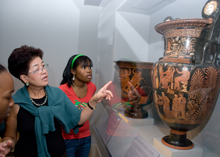Research
July 19, 2010
Metro students can use Carlos as classroom

Carlos Museum docent Tip Weniger shows students around the Greek and Roman Art Gallery.
Educators throughout the city are using the collections and exhibitions of Emory’s Carlos Museum to enliven their curriculum and engage their students.
Through works of art, a student can directly experience the civilizations of the ancient world, says Elizabeth Hornor, the Carlos Museum’s Marguerite Colville Ingram Director of Education. The museum can serve as an extension of the classroom, she says.
“At a time when field trip budgets are being cut and seen as extracurricular, we are trying to press upon educators that the study of objects made by ancient hands is not extracurricular,” Hornor says.
These objects offer ways into the study of belief systems, societal structures and trading patterns of the civilizations that created them, a look at the geography and natural resources of a region, and the ways in which each civilization responded to their environment.
Julie Green, the museum’s senior manager of school programs, has worked with teachers and curriculum coordinators, museum curators, Emory faculty, and members of the museum’s docent guild to develop tour programs that meet Georgia Performance Standards.
The Carlos Museum can serve as a curriculum-based learning laboratory for areas of study including the ancient Americas in sixth grade, world religions and the history of Africa in seventh grade, the ancient Mediterranean in world history, and “The Odyssey” and “The Aeneid” in high school literature and Latin classes. School reading specialists can even tour the collections with the characters from Rick Riordan’s popular Percy Jackson novels, Hornor says.
Green spends a good part of every August meeting with K-12 teachers and curriculum coordinators. The goal is to let them know about the exhibitions, PLU (Professional Learning Unit) courses, workshops for teachers and tour programs for the upcoming academic year, introducing them to the pedagogy of object-centered learning.
